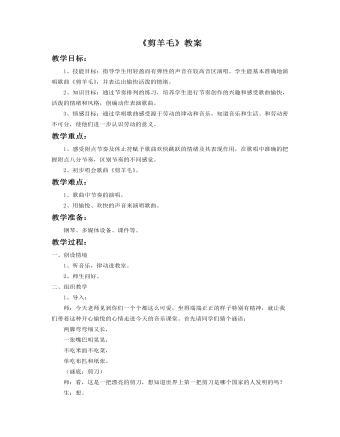人教版新课标PEP小学英语五年级下册Recycle1教案(内容详细)
-
- 页数:13页
- 字数:约 9960 字
- 大小:53.88KB
- 格式:.docx
- 版本:Office2016及以上版本
- 作者:老余工作室
Recycle1教案
第一课时教学设计
教学重点:
综合运用第一单元的中心语言,对一天的活动进行有条理的表述。
教学难点:
语篇的叙述和写作是本单元的重点,教师本节课应让学生模仿Listen and write部分内容,并同时提供一些语言框架,从而降低学生完成的难度。

课前准备:
资源中心的相关素材。
第一单元动词短语卡片。
学生制作自己的时间表。
录音: Listen and write部分;活动手册P25—1。
Ask and answer部分两张活动时间表的挂图。
Ask and answer部分对话材料复印件。
教学过程:
Warm up (热身)
活动一复习短语
教学参考时间:5分钟
教师播放录音,全班一起说唱第一单元歌曲“Weekend”和“Let’s chant”部分歌谣。
出示动词短语卡片,教师做动作,请学生猜短语并找出相应的卡片,进行认读,然后师生共同拼读,并板书。
帮助学生回忆第一单元短语,为下面的问答练习充分准备。
活动二连锁问答
教学参考时间:5分钟
教师先提问一名学生:When do you get up? 该学生回答后,继续用黑板上的其他词组提问下一名学生:When do you … ?,进行连锁问答活动。(教师将学生回答的时间记在黑板的短语后。)
教师将全班分成四大组进行连锁问答比赛,四个组同时进行,教师计时。声音最亮,口齿最清晰,耗时最短的组获胜。(教师提示前后两名学生不能提问同一内容。)
操练句型When do you … ?(I …)At …,为Ask and answer部分进行铺垫。
Presentation (新课呈现)
活动三学习短语
教学参考时间:4分钟
(1)教师出示Ask and answer部分两张表格的挂图:This is Zhang Peng’s timetable in asports camp and this is Amy’s timetable in a computer camp. What dothey do? 请学生读读表格中的短语。
(2)请学生认读:have computer lesson,play ping-pong,教师要适时通过have English class和play football引导学生理解have computer lesson和play ping-pong的意思。
点击单词recess,学生跟读,讲解中文意思:休息。
初步了解Zhang Peng和Amy的生活安排,认读短语。
活动四角色扮演
教学参考时间:5分钟
(1)教师发对话材料复印件每人一张。(同桌两个学生一人发材料一,另一人发材料二。)
材料一
Amy’s timetable ZhangPeng’s timetable
Time
Activity
Time
Activity
6:30 a.m.
get up
get up
6: 50 a.m.
eat breakfast
eat breakfast
8: 00 a.m.
do morning exercise
do morning exercise
8:30 a.m.
have computer lesson
swim
11:30 a.m.
eat lunch
eat lunch
1:30 p.m.
have computer lesson
play football
6:30 p.m.
eat dinner
recess
8:30 p.m.
play computer games
play ping-pong
9:30 p.m.
go to bed
eat dinner
watch TV
go to bed
材料二
Amy’s timetable ZhangPeng’s timetable
Time
Activity
Time
Activity
get up
6: 00 a.m.
get up
eat breakfast
6:30 a.m.
eat breakfast
do morning exercise
7:30 a.m.
do morning exercise
have computer lesson
6:30 a.m.
swim
eat lunch
11:30 a.m.
eat lunch
have computer lesson
1:30 p.m.
play football
eat dinner
3:00 p.m.
recess
play computer games
4:30 p.m.
play ping-pong
go to bed
5: 00 p.m.
eat dinner
7: 00 p.m.
watch TV
8:30 p.m.
go to bed
(2)学生两人一组分别扮演Zhang Peng和Amy,进行Pair work,询问对方的活动时间安排,同时完成表格时间的填写。-
A:When do you … ?
B: At …
教师巡视检查,看学生能否灵活自如的使用第一单元句型完成调查。
在调查活动中进一步应用第一单元所学的功能结构。
Exercise(巩固练习)
活动五听力练习
教学参考时间:3分钟
教师播放Listen and write部分录音,学生先听一遍,听第二遍时填写Timetable。
从听力、拼写方面检验学生对第一单元内容的掌握情况。
活动六语篇叙述
教学参考时间:5分钟
将Listen and write部分内容提供给学生:
I usually get up atthree thirty in the morning. I go to work at four (go to school at … ). I finish my workat about six in the morning ( go home at …). I eat breakfast atseven. Then I clean my room. I stay at home in the day. I eat dinner at aboutseven in the evening. I go to bed at eight. What do I do? I am a streetcleaner. 请学生朗读。
参照以上语言框架和学生自己制作的时间表,向全班同学介绍自己一天的作息时间。
训练学生连续表达的能力。
Extension 巩固与扩展
活动七练一练
教学参考时间:6分钟
完成活动手册P25—1
学生自己看图试着说句子;
教师播放录音2遍,学生完成填空。
完成活动手册P26—2
学生自己阅读对话,完成判断题
答案:Wu Yifan goes toschool at 7:30.T
Wu Yifan’s favorite class isEnglish. F
Wu Yifan likesplaying ping-pong.T
Wu Yifan has four orfive classes every day. F
Wu Yifan has paintingclass on the weekend.T
活动八小结
教学参考时间:2分钟
出示Ask and answer部分两张时间表,男生扮演Zhang Peng,女生扮演Amy,进行问答练习——A:When do you … ?
B: At …
活动九写作练习
(可作为家庭作业)
写一篇主题为“My Day”的短文。
五、板书
第二课时教学设计
第二课时
教学重点:
有关描述四季特征和表达自己最喜欢季节及原因的语句。
教学难点:
学生仿照Read and write中的语篇写作小短文前,教师应先口头示范,并板书关键词和语句结构供学生写作时参考。
课前准备:
资源中心的相关素材。
加拿大四季风光的图片。
Read and answer部分录音;活动手册P28—3的录音。
教学过程:
Warm up (热身)
活动一歌曲歌谣
教学参考时间:5分钟
播放第二单元“Let’s chant”部分歌谣,全班一齐说唱。
播放歌曲“What’s your favouriteseason?”,学生吟唱。
教师播放Let’s sing部分歌曲“Songs of the season”,学生欣赏;请学生说说在歌词中听到的单词,教师讲解歌词大意。
学生跟录音学唱歌曲。
在热身活动中初步回忆第二单元的内容。
活动二师生谈话
教学参考时间:3分钟
T:What season is it?
S:It’s spring. (板书季节名称)
T:What’s the weather like inspring?
S:It’s windy, but warm.(板书天气特征)
T:What do you wear?
S:Sweater / Dress / jacket……
T:What can you do in spring?
S:We can go hiking. We can plant trees. We canfly kites…….(板书动词短语)
教师出示其他三个季节的图片,进行类似的对话练习。
在交谈中巩固第二单元的短语和功能结构,为Write and say部分内容进行铺垫。
Listening and talking(听说练习)
活动三听力练习
教学参考时间:3分钟
教师播放活动手册P28—3的录音每句话两遍,第一遍学生听,第二遍进行填写。
答案: spring plant trees winter make a snowman
summer swim in the sea fall climb mountains
在听力练习中引出有关最喜欢的季节及在该季节活动的语句,同时巩固单词的拼写。
活动四小组调查
教学参考时间:4分钟
教师就板书内容对我国的四季特征及人们相应的活动进行综合描述。
教师提问:Hello, boys and girls. What’s your favouriteseason ? Why? 请几名学生回答并说出原因。原因可涉及气候、穿着及可在该季节进行的活动。
请学生打开教材第40页,进行Pair work,展开问答并填写表格。
学生完成表格后,教师对全班学生的favourite season进行调查,并记录人数。
初步应用所学语言口头表达自己最喜欢的季节和原因,为语篇的阅读和写作做准备。
3、Reading and writing(读写练习)
活动五阅读练习
教学参考时间:10分钟
教师出示加拿大四季风光图片:Look, thesepictures are about Canada. Seasons in our country are different from those inCanada. What are they like in Canada? 启发学生说说图中的季节和天气。
激发学生的阅读兴趣。
学生自己阅读短文,初步了解短文的意思。
教师出示句子:
And it is hard toplant flowers in the rain.
It is so nice towatch the flowers grow.
I also love to watchthe leaves fall. Is that why we can call autumn “fall”.
They are allbeautiful and I can find many things to do.
启发学生理解句子意思;模仿录音朗读,注意适时停顿。
解决学生在理解中的障碍。
跟录音朗读短文。
教师出示句子,学生用Yes或No来判断是否与短文内容相符:
Mike loves summer. Hecan swim in the sea. (Yes)
In Canada, It oftensnows in spring.(No)
It is so nice towatch the flowers grow in summer. (No)
We can call autumn “fall”. (Yes)
It usually snows inwinter in Beijing. (No)
All the seasons arebeautiful. (Yes)
检验学生的理解情况。
请学生阅读并回答短文后的两个问题:(教师可以启发学生先画出相关句子,再转换人称进行叙述。)
What can Mike do in the four seasons?
In summer, he can swim; In spring, he canplant flowers and watch them grow; In autumn, he can pick apples and watch theleaves fall; In winter, he can ski.
Which season does Mike like best?
He loves all the seasons. Because they are allbeautiful and he can find many things to do.
对短文内容的简单复述。
活动六语篇写作
教学参考时间:5分钟
(1)请几名学生结合板书和图片,模仿短文对当地的四季特征进行口头描述,对于学生说出的有创意的句子,教师要给予鼓励,并写在黑板上,供学生短文写作时使用。
充分的口头表达是写作的基础。
(2)课堂上教师可与学生写作一至两个季节,学生再课后独立完成其他季节的写作。
4、Consolidation andextension(巩固与扩展)
活动七练一练
教学参考时间:5分钟
完成活动手册P27—3
学生独立完成排列句子;
教师请几名学生说出答案;
学生根据重排好的句子再进行对话练习。
练习3答案:
Which season do youlike best?
It is too cold forme.
Why do you likewinter?
I like winter best.
Because I can make asnowman.
I don’t like winter.
How about you?
Do you like winter.
练习4答案:
01- 04- 03- 05- 07-08- 06- 02
活动八小结
教学参考时间:2分钟
学生朗读Read and answer部分短文。
学生将自己写的短文朗读给家人或朋友听。
五、板书
Recycle1(2)
China Canadado
Spring
windy,warm
often raingo to the park;
Plant trees and flowers
Summer
hot
hotswim
Autumn
sunny,cool
coolpick apples
Winter
sometimes snows
often snowsmake a snowman;ski
第三课时教学设计
教学重点:
问答中外重要节日及部分中外名人的生日所在的月份或季节。
教学难点:
正确表达中外重要节日及部分中外名人的生日所在的月份或季节。
课前准备:
资源中心的相关素材。
12个月的单词卡片。
学生搜集中外重要节日及部分中外名人的生日所在的月份。
教师准备相关节日及部分中外名人的图片或音像资料片。
您可能喜欢的文档
查看更多
人教版新课标PEP小学英语五年级上册Recycle1教案
- 页数:4页
- |大小:24.15KB

人教版新课标PEP小学英语六年级下册Recycle1 Let’s Take a Trip教案
- 页数:11页
- |大小:51.55KB

人教版新课标PEP小学英语六年级上册Recycle1教案
- 页数:5页
- |大小:41.67KB

人教版新课标PEP小学英语四年级上册Recycle1教案2篇
- 页数:11页
- |大小:36.81KB

人教版新课标PEP小学英语五年级下册A Field Trip教案
- 页数:31页
- |大小:68.40KB

人教版新课标PEP小学英语五年级下册My Favourite Season教案
- 页数:17页
- |大小:42.94KB

人教版新课标PEP小学英语五年级下册My Birthday教案
- 页数:16页
- |大小:44.55KB
热门课件教案

《剪羊毛》教案
- 页数:3页
- |大小:33.50KB
- 课件教案

部编版六年级语文上册《草原》教案
- 页数:6页
- |大小:265.86KB
- 课件教案

部编版语文八年级下册《马说》教案
- 页数:8页
- |大小:367.50KB
- 课件教案

部编版语文八年级下册《社戏》教案
- 页数:8页
- |大小:340.00KB
- 课件教案

精选高中生期末评语
- 页数:42页
- |大小:7M
- 课件教案

人教版高中语文《小狗包弟》教案
- 页数:8页
- |大小:29.21KB
- 课件教案
今日更新

精选高中生期末评语
- 页数:42页
- |大小:7M

××县招商局2024年上半年工作总结
- 页数:12页
- |大小:142.54KB

“四零”承诺服务创建工作总结
- 页数:5页
- |大小:39.83KB

“改作风、提效能”专项行动工作总结
- 页数:6页
- |大小:139.05KB

“大学习、大讨论、大调研”活动情况总结报告
- 页数:7页
- |大小:26.12KB

2024年度工作计划汇编(18篇)
- 页数:72页
- |大小:196.93KB





